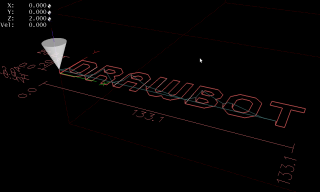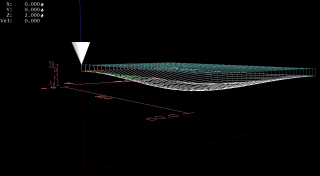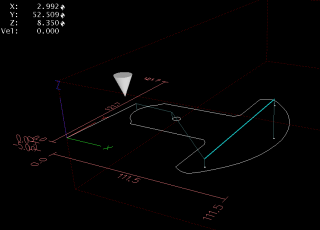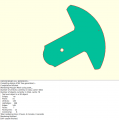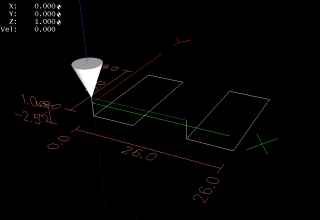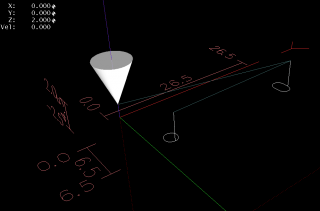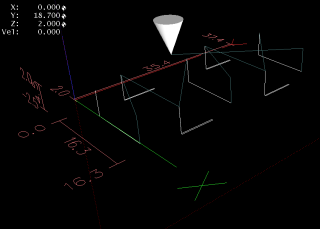Info zur Zen Toolworks 1212
- Daniels Leihgabe an den Hackerspace Ffm
- Typ Zen Toolworks 12x12 Inch
- Hersteller: Zen Toolworks
- Zen Toolworks CNC
CNC Revival project
Ziele
- Dezember 2011 - Februar 2012
- Fräse betriebsbereit und getestet
- Materialen
- Epoxy / Glasfaser / Platinen-Herstellung
- Holz
- Acryl
- Holz
- Aluminium ?
- Platz in der Werkstatt wg.
- Lärm
- Abzug / Entlüftung
- Staub
Hardware, Software
- Anschluß zunächst über Parallel-Port / Centronics
- geplant: USB Interface
- Betrieb mit freier Software
- Linux / Ubuntu
- Logon: CNCuser
- EMC
- EMC on Ubuntu Live CD (erfolgreich getestet am 10.12.2011 / CNC and 3D Dual-Boot PC)
- EMC forum / emcinfo.pl
- CNC and 3D Dual-Boot PC
- Spannungsversorgung
- separates Netzteil 5 Volt ersetzen durch Spannungsregler / 7805 und Anschluß an 12 Volt Haupt-Versorgung
- Home End-Stopps / Max. End-Stopps
- optisch / mechanisch?
Tests am 10.12.2011
Joypad Steuerung
- 14.12.2011
- Konfiguration eines Logitech Logitech Dual Action Joypad an EMC zu Steuerung der X, Y, Z Achsen
- 2 Geschwindigkeiten über Buttons wählbar.
- Joypad auf wiki.linuxcnc.org
Production mode
Inkscape g-code Export
- 14.12.2011
- Inkscape unter Ubuntu
- InkscapeHowto auf wiki.linuxcnc.org
- Export Plug-in für Inkscape
- Test-Datei Walking Camel von http://www.clker.com
Bohren der LED Platinen für das Buntich Projekt
- Massen-Bohrung für das Buntich Projekt
- je 4 Bohrungen je LED Platine
- Abstand Y: 1/10 Zoll = 2.54 mm
- Abstand X: 21,86 mm
- Bohr-Tiefe 2.5 mm
feed-rate F = 50-70 mm / min., Rückzug 150 mm / min.
- 18 Platinen, je 6 Buntich-Pixel, je 4 Löcher = 432 Löcher
Beispiel g-Code, per Text-Editor
% (Bohren der LED Platinen für das Buntich Projekt) (AXL für Hackerspace FFM, 17.12.2011) M3 (Header end.) G21 (All units in mm) G00 X0.0 Y0.0 Z-0.0 G01 Z-2.5 F70 G00 Z-0.0 G00 Y+2.54 G01 Z-2.5 F70 G00 Z-0.0 G00 Y+5.08 G01 Z-2.5 F70 [...] G00 X21.86 Y0.0 G01 Z-2.5 F70 G00 Z-0.0 [...]
Platinen fräsen und bohren
- CAD für PCB Entwurf: Win Layout von Abacom
- Bohren
- Ausgabe im Excellon Format
- Umwandlung über Excellon to G-Code Convertor
- Fräsen
- HPGL Export und Konvertierung in g-Code mit Inkscape
- (siehe Zen Toolworks CNC Fräse#Inkscape g-code Export)
XYZ Blinkenlights for CNC Mills
- LED-Circles für die X-, Y-, Z-Achse
- Bohrvorlage für 5 oder 3 mm LED-Circles in Processing
- Ausgabe der g-Codes direkt aus Processing
Drawbot Logo
- Ausgabe des Drawbot Fonts per Processing in g-Code
- Fräsen in Bastel-Kunststoff (grau) und Acryl
- Fräs-Test für ein Teil des Prusa Air
- Zen Toolworks CNC
Kissen / Gußform Test
- Fräsen einer Kissen-Form in Schaustoff
- Erstellen des G-Code mit Processing als Überlagerung von zwei Sinus-Funktionen für die Z-Achse ("Tiefe")
- Anwendung: Guß-Vorlage für Lautsprecher-Boxen
[...]
for (float iy=0; iy <= my; iy += w) {
s.add(new String("G00 Z" + fpp(h_save)));
s.add(new String("G00 X0 Y" + fpp(iy)));
float ky = sin((iy / my) * pi);
for (float ix=0; ix <= mx; ix += w) {
float kx = sin((ix / mx) * pi);
z = h1 * kx * ky;
s.add(new String("G01 X" + fpp(ix) + " Z" + fpp(z) + " F" + fpp(f)));
}
}
[...]
Drawbot Gondel-Teil - OpenSCAD
- Fräsen eines in OpenSCAD konstruierten Teils aus Kunststoff
- OpenSCAD Export als 2D DXF Datei - s.u.
- Konvertierung in g-Code mit Inkscape
OpenSCAD 3D zu 2D Konvertierung
[...]
// projection(cut=true) for DXF extrude
projection(cut=true) rotate([180,0,0]) {
[... 3D parts here ...]
} // projection(cut=true) for DXF extrude
Probleme
- DXF Import
- Pfad wird beim Export nicht zusammengeführt
- "händische" Aufbereitung nötig, u.a. per Shell mittels:
cat PenDisc_V_003_combined_paths_0006.ngc|grep "G00 X"|awk '{print "G01 " $2 " " $3 " F80"}' > PenDisc_V_003_combined_paths_0006_filter.ngc
- Dimensionen
- OpenSCAD Modell hat Breite des Fräsers nicht beachtet (Radius 1.1 mm)
rm=1.1; // radius mill tool rh1=4; // center hole rh2=1.5; // holes [...] cylinder(r=rh2-rm, h=10, center=true, $fn=20);
- Zen Toolworks CNC
Buntich Aussparungen für Kabelkanäle
Buntich Datenleitungen
- Fräsen rechteckiger Aussparungen in die Buntich Kabelkanäle
- Direktes Editieren des G-Code per Text-Editor
- Zen Toolworks CNC
Buntich Datenleitungen - g-Code
% (Bohren der Kabelkanäle für das Buntich Projekt) (AXL für Hackerspace FFM, 07.01.2012) M3 (Header end.) G21 (All units in mm) G00 Z+1.0 G00 X+0.0 Y+0.0 G01 Z-2.5 F160 G01 Y+19 F160 G01 X+8 F160 G01 Y+0 F160 G01 X+0 F160 G00 Z+1.0 G00 X+18.0 Y+0.0 G01 Z-2.5 F160 G01 Y+19 F160 G01 X+26 F160 G01 Y+0 F160 G01 X+18 F160 G00 Z+1.0 G00 X0.0 Y0.0 (end) %
Buntich 4mm Stecker
- 1 Loch 4mm, 1 Langloch 5mm x 4mm
- gefräst mit 2mm Fräser
Buntich Kabeldurchführung
- 3 Schlitze für Flachband-Kabel
- 2 x 2 Schlitze für Zugentlastung 10-polige Buches für Wannenstecker
- Muster 16 mal in Kebelkanal eingefräst
- Zen Toolworks CNC























